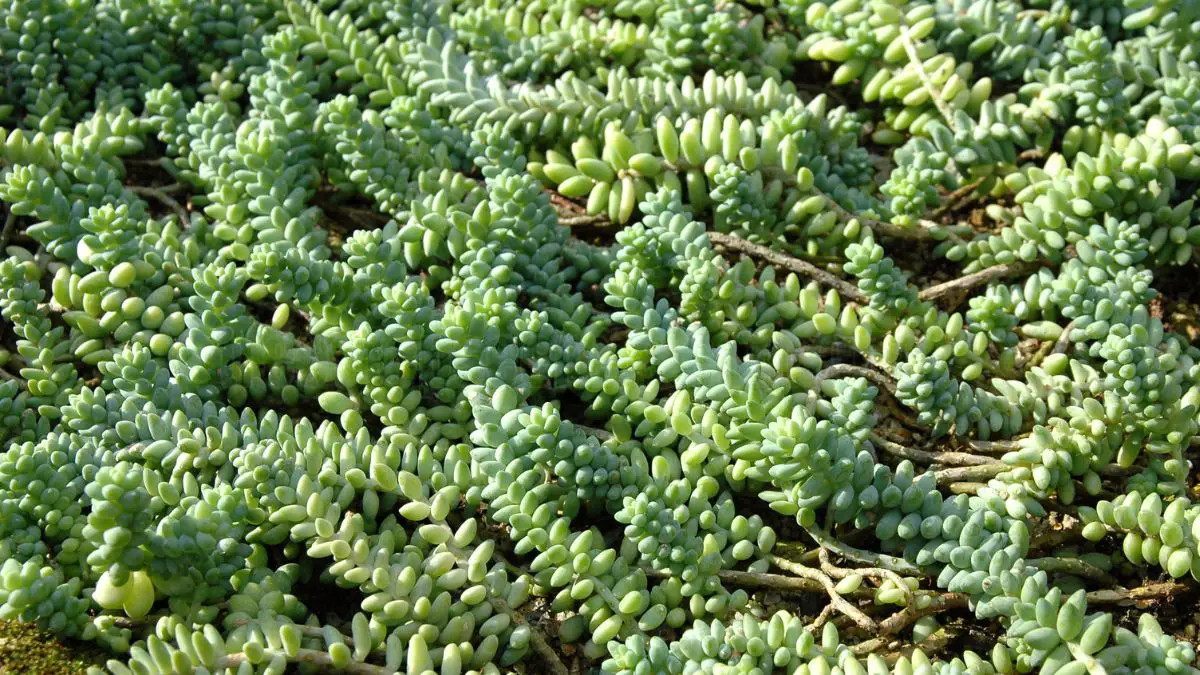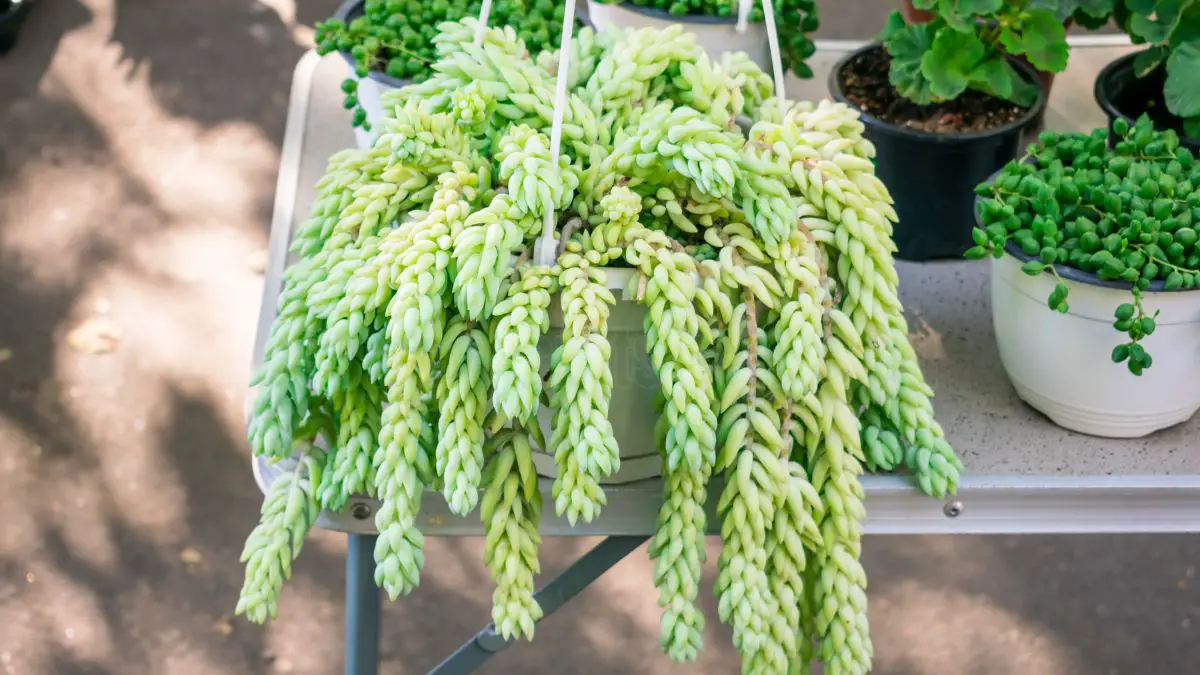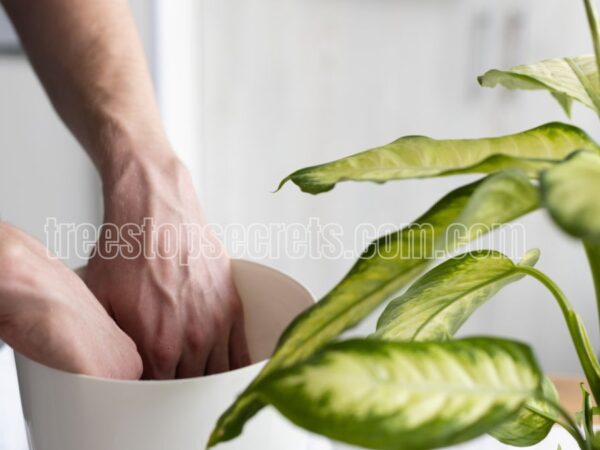Here’s what you need to know about providing your sedum burrito with the proper light conditions to thrive indoors. Don’t forget about the right watering and soil, either! This delightful plant native to Mexico has the cutest, chubbiest leaves that spill over elegantly.
Because of this, it does well in bright, indirect sunlight, so it’s perfect for your indoor garden. Other care tips: Water with a light hand, letting the soil dry out completely before watering again to avoid root rot.
Planting your sedum burrito in a well-draining soil mix will keep it happy and healthy. Provide this hardy houseplant with just the right amount of care, and it’ll reward you handsomely.
When cared for properly, it can bring the beauty of nature and cheerfulness into your home, making your living space vibrant and unique.
Key Takeaways
- Sedum burrito – also known as “burro tail” or “donkey tail” – is a beautiful, low-maintenance succulent. This resilience to changeable indoor environments makes Sedum burrito an excellent option for novice gardeners and time-strapped hobbyists. Its striking trailing habit makes it a lovely addition to any space.
- Keep your sedum burrito in a spot where it can soak up 6 or more hours of bright, indirect light per day. Especially during the winter months, supplement with grow lights if needed so your sedum burrito can thrive indoors.
- Create a watering routine in the growing season, every 2 to 3 weeks. In the winter, water less often. Water using the soak and dry method so you don’t overwater your plant and cause root rot.
- Pick a fast-draining cactus and succulent mix. Try mixing in some perlite or coarse sand to promote drainage and air circulation around the roots.
- Ensure indoor temperatures are at least 60°F and no more than 80°F. Keep humidity levels between 30-50% to provide optimal conditions for your sedum burrito to thrive!
- Check your plant often for pests like aphids or mealybugs. Fight any outbreaks as soon as possible with neem oil or insecticidal soap to ensure your plant continues to flourish.
Understanding Sedum Burrito
Sedum Burrito, an extraordinary trailing succulent, fascinates indoor gardeners with its highly aesthetic appearance and minimal care. This gorgeous succulent is native to the warm climates of southern Mexico and Honduras.

It does best in conditions that mimic its native range, which adds to this beauty’s remarkable hardiness. One reason it’s become so popular is its low maintenance requirements. This is what makes it a perfect option for both expert and beginner plant enthusiasts alike.
What is Sedum Burrito?
Sedum Burrito, scientifically known as Sedum morganianum, is cherished for its thick, teardrop-shaped blue-green leaves that create a stunning trailing succulent. Commonly referred to as the "burro tail" or "donkey tail," this plant showcases a unique growth habit that makes it a favorite among succulent enthusiasts. When placed indoors, it elegantly drapes over pots or hanging planters, adding a gorgeous burrito sedum touch to any room. Over time, its stems can reach impressive lengths—up to 2 feet, and at full maturity, they can extend to an astounding 4 feet.
This hardy plant, popularly known as "Hens and Chicks," features adorable plump, fleshy leaves that enhance its charm. Its mesmerizing trailing stems make it ideal for indoor gardens, providing a beautiful and unusual accent to your home. With proper care, including a suitable succulent soil mix, Sedum Burrito can thrive and flourish, making it a delightful addition to your collection of tail succulents.
Why Choose Sedum Burrito for Indoor Spaces?
The visual beauty of Sedum Burrito brings a natural touch to any indoor space, complementing a wide range of decorative styles. Its ability to thrive in a variety of lighting conditions, including bright, indirect light and partial shade, makes it incredibly versatile.
The plant’s drought tolerance means that it can live happily even when not watered regularly. This capability is what makes Sedum Burrito ideal for the person on the go.
Giving your plant soil that drains easily is very important. Yellowing leaves are a sign of root rot, so avoid overwatering.
Ideal Lighting Conditions
Providing the perfect lighting conditions is key to the healthy development of Sedum burrito, named as Burro’s Tail. Plants that do best under these conditions typically need a lot of ambient light, at least 6 hours of bright, indirect sunlight each day. This exposure encourages ideal photosynthesis, which helps the plant store energy and develop a strong, healthy plant.
It’s very important to calibrate and get that balance just right. Too much strong, direct sun will burn the leaves and possibly even shock your plant.
1. What Light Levels are Best for Sedum Burrito?
To keep your Sedum burrito happy, set it where it can get a lot of bright indirect light. If you’re not able to provide natural light for them, especially in the winter months, use grow lights as a supplement.
Monitor your plant’s response to varying light intensities. If you begin to notice signs of stress such as wilting or yellowing, relocate the plant to a more ideal location.
2. How to Position Your Plant for Optimal Light Exposure?
Aim to keep your Sedum burrito in a room with a bright window. An east- or west-facing window is perfect for soft morning or late-afternoon rays.
It is a good idea to periodically rotate the plant to encourage consistent light exposure on all sides. If you do see strong midday sun, try putting up sheer curtains to soften the light without making the space dark.
This configuration will distance the plant from aggressive, leaves-damaging lights while allowing it to do its best in its new indoor home.
Watering Guidelines
Sedum Burrito, a stunning trailing succulent, requires its watering schedule to be as regular as clockwork. This will avoid unnecessary stress to the sedum burrito plant and ensure productive growth. When the seasons change, so should your watering habits to keep your gorgeous burrito sedum thriving.
1. How Often Should You Water Sedum Burrito?
For optimal growth, water your Sedum Burrito every 2-3 weeks in the growing season. During the winter months, reduce how often you water the soil. My rule of thumb for watering is every 10-14 days, soaking the soil deeply each time.
Following the “soak and dry” principle avoids waterlogging. This method consists of watering the plant completely until water runs out of the bottom of the pot. In summertime and in winter months when the plant is inactive, one watering a month usually is enough.
Keep an eye on the temperature and light level in your home. All these factors play a huge role in what your plant will need.
2. Signs of Overwatering and Underwatering
Knowing the symptoms of overwatering and underwatering is extremely important. Yellowing leaves and mushy stems are obvious signs that you’re overwatering. Curled leaves and bone-dry dirt indicate that your plant isn’t getting enough water.
Paying close attention to your Sedum Burrito will help you identify these problems quickly and make the necessary care changes. Preventing splash-and-go watering every other day will help make sure that the plant gets all the hydration it needs without doing any damage.
Finally, if you’ve collected rainwater, make sure to use it during the winter for a cool, tasty beverage.
Soil and Potting Mix Requirements
For your sedum burrito plant to thrive, it’s crucial to understand its soil and potting mix requirements. This gorgeous burrito sedum requires a well-draining soil that helps prevent root rot. Like all tail succulents, sedum burrito likes it on the dry side, as wet soil can drown roots, leading to rot. Thus, selecting the proper soil mix should be the first step.
1. What Type of Soil is Best for Sedum Burrito?
Choose a well-draining cactus or succulent potting mix formulated for their unique needs. This combination encourages drainage and aeration, vital elements in ensuring your sedum thrives.
To increase texture, try mixing in some perlite or coarse sand. Both substances will make the soil more drain-friendly. Stay away from dense, moisture-retaining soils. They are a cause of root rot, something that sedum varieties are notorious for succumbing to.
2. How to Create the Perfect Potting Mix?
Making your own perfect potting mix can be easy. An easy three-way mix of potting soil, perlite and coarse sand or grit works well.
To test your mix, water the soil and see how fast it dries out. This quick test will make sure you’re getting good drainage. Continue to modify the mix according to your specific outdoor climate and indoor houseplant humidity.
This is going to make your sedum burrito healthier and better able to withstand fluctuations in environmental conditions.
Temperature and Humidity Needs
If you want to grow sedum burrito successfully inside, it’s important to know it’s temperature and humidity requirements. This succulent likes it warm, ideally in a range of 60°F and 80°F. It is tolerant to minor temperature fluctuations, but you need to shield it from harsh cold.
Temperatures around or below 50°F can cause undue stress on the plant.
1. What are the Optimal Temperature Ranges?
Sedum burrito indoor care requires that the indoor temperature remains above 50°F, particularly during the winter months. Make sure to prevent the plant from being exposed to cold drafts and heating vents. A big jump in one direction or the other will definitely freak it out!
It is truly valuable to have continuous monitoring of indoor temperatures, especially during transitional seasons when heating or cooling systems are operating. Keeping the cut flower at an even temperature is important to prevent fading of color and premature development.
2. How Does Humidity Affect Growth?
This humidity-loving succulent does best in the lower humidity levels that indoor environments provide. Sedum burrito thrives in 30-50% humidity range, so it’s a perfect match for most households.
A humidity meter is helpful for monitoring humidity levels and making sure they remain in this range. Prevent high humidity levels to help prevent pest and disease problems in your plants. Too much water encourages fungi and creates other issues.
Pest Management Strategies
Controlling pests is an important aspect of keeping your gorgeous burrito sedum happy. If common pests such as aphids and mealybugs are not managed, they can cause significant damage to your sedum burrito plant. Consistent inspections are imperative for identifying infestations early, thus reducing the risk of damage to your stunning trailing succulent.
1. Common Pests Affecting Sedum Burrito
Along with aphids and mealybugs, spider mites and whiteflies pose a frequent menace. Spider mites spin very fine webs, and they can cause the leaves to yellow and fall off.
Whiteflies will result in yellowing leaves and leaf drop. Identifying these signs early is key, but yellowing and drooping are usually the first signs that something is wrong.
Keeping the area surrounding your sedum burrito free of debris and other organic matter is a must. Dust and dirt can be a magnet for pests, so regularly dusting your equipment and workspace makes it less appealing for pests to stick around.
2. How to Identify and Treat Infestations?
Once you know the pests to look for, check the undersides of leaves, where many pests like to hide. Check for small bugs or honeydew, a sign of a serious infestation.
If you do discover pests, quarantine the infested plant as soon as possible to avoid spreading them. Rapid application of treatments such as neem oil or insecticidal soap will be most effective and can go a long way.
These solutions provide an effective treatment for established pests as well as a barrier to prevent future infestations. Applying these treatments quickly will cause the least harm possible and get your plant back to thriving in no time.
Propagation Techniques
Propagating sedum burrito indoors is a simple propagation technique that will help houseplant enthusiasts grow their indoor jungles with minimal effort. This lovely succulent, adored for its pretty hanging stems and chunky leaves, is an easy plant to propagate from leaf or stem cuttings.
This improves and diversifies your collection and provides a fulfilling experience as you watch for signs of new life to emerge.
1. How to Successfully Propagate Sedum Burrito Indoors?
Firstly, start with cuttings from the green, hearty stems. Try to get pieces that are at least three to four inches long. Once cut, allow them to callus for a few days in a dry, shaded location so that they do not rot when planted.
When they are prepared, plant them in an appropriate, well-draining potting mixture that has plenty of perlite or coarse sand to promote vigorous root growth. It’s very important to make sure the cuttings are in bright, indirect light until roots have developed.
This level of light closely resembles their native environment and encourages strong, vibrant growth.
2. Best Practices for Rooting Cuttings
Maintaining even moisture is important while rooting is taking place, but do not overwater as this can cause rot. Using a humidity dome or even a simple plastic bag can help to keep moisture in, creating a mini-greenhouse effect.
Provide adequate air flow to avoid mildew from forming. As soon as you have roots, usually two to four weeks, pot on the new plants into larger containers.
We hope this shift will further nurture that growth.
Repotting Best Practices
Repotting the gorgeous burrito sedum is an important part of maintaining this hardy plant's health. This practice allows you to refresh the succulent soil, providing new nutrients and preventing any potential root issues. Generally, repotting every 2 years will ensure the sedum burrito plant has ample space to thrive and flourish.
1. When Should You Repot Sedum Burrito?
The ideal time to repot is during spring, which coincides with the plant’s active growth phase. Don’t repot until you’ve examined the roots first. If they are tightly packed or circling around the pot, it’s a clear sign that your plant needs more space.
When you’re repotting, take some time to look for any damaged roots and cut them off. This simple step encourages optimal growth. Fresh potting mix provides new nutrients that your Sedum needs to stay healthy and thrive.
2. Steps for a Successful Repotting Process
Start by gently taking your Sedum out of its existing pot. Wriggle the pot gently, being careful not to disturb the roots too much, to loosen the dirt. When you do take it, loosen any compacted soil, and trim back dead or unhealthy roots.
Especially if the plant is in rough shape already, this attention to detail can be what makes or breaks your plant’s recovery. Now, set your Sedum into its new, somewhat larger pot. Backfill with new potting soil, making sure it is evenly dispersed around the roots.
Water well to ensure the soil settles into place and that your plant gets acclimated to its new digs.
Indoor Air Quality and Circulation
Indoor air quality is hugely important to the health and development of your Sedum Burrito. We know that clean air is essential for healthy plant growth, since pollutants like ozone can cause stress and reduce growth rate. For instance, these sensitive succulents can be easily damaged by exposure to smoke or harsh chemicals.
You usually encounter these toxic chemicals in cleaning products or paint. Cleaning your indoor plant leaves on a regular basis helps them photosynthesize at their full potential. This allows them to maximize the light they require to survive and grow.
1. How Does Air Quality Impact Growth?
Sedum Burrito isn’t too thrilled with suboptimal air quality conditions. Toxic stagnant air can cause stress, which in turn causes stunted growth. This is why it’s important to stay away from smoke or keep your plants away from strong cleaning products.
Regularly cleaning the leaves will help ensure they receive maximum light absorption, helping to promote healthy, vigorous growth. Just gently wiping leaves with a clean, damp cloth can go a long way.
2. Tips for Improving Indoor Air Circulation
Proper air circulation is crucial for your plants. Not only is good air circulation important to prevent mold, but pests can thrive as well. Place your plants where there is good air circulation, avoiding crowded areas that limit air flow.
Oscillating fans are great for circulating air gently, which not only helps keep the air fresh, it keeps it from becoming stagnant. Turn your plants periodically to ensure that all sides receive airflow. This creates even growth throughout the soil and minimizes the chances of issues such as mold.
Decorative Displays and Care Tips
Not only is incorporating the gorgeous burrito sedum into home decor visually stunning, it’s incredibly versatile. This stunning trailing succulent’s unique trailing nature gives it a luxurious, cascading effect that pulls the eye and adds drama to any space. Sedum burrito has thick leaves and deep green color, making it a hardy plant that is sure to bring a pop of color to your shelves, windowsills, or coffee tables.
1. Can Sedum Burrito Enhance Indoor Decor?
The beautiful trailing nature of sedum burrito makes for a simple way to add color and life to your indoor space. Planting in bright pots can accentuate Sedum Burrito’s unique leaves, creating eye-catching compositions. For example, combining sedum burrito with terracotta or ceramic pots in warm, vibrant colors can add a touch of coziness to a space.
Use plants of varying heights to make an eye-catching arrangement. Position taller varieties around sedum burrito’s low profile to leave the viewer’s eye moving.
2. Care Tips for Arrangements with Sedum Burrito
When planning an arrangement, try to select only plants with the same level of care and appreciation for their environments. This compatibility will make it easier to water and maintain. A good quality, well-draining potting mix is crucial as it nourishes various plants and staves off root rot.
Regular maintenance goes a long way in preserving your displays. Pruning away any dead foliage and gently removing dust with a damp cloth can go a long way toward keeping these plants looking their best.
Conclusion
Watching your Sedum Burrito grow and thrive as an indoor houseplant will be a rewarding experience, adding beauty and life to your home. When given ample light, water, and well-draining soil to grow in, your plant will flourish and bring fresh beauty indoors. Monitor the temperature and humidity closely to help your burrito thrive. The sooner you can manage pest outbreaks, the less damage your plants will sustain. Whether propagating or repotting, take care and avoid easy mistakes for best results.
Making a beautiful arrangement with your plant can enhance any space you’re in, adding color and life. Take pride in the fact that you’re growing a unique plant like Sedum Burrito, and enjoy seeing it thrive under your care! Begin your planting adventure right now, and show the world your green thumb! Show us your largest or most beautiful plants, and get advice from other plant enthusiasts!
Frequently Asked Questions
What is Sedum Burrito?
Whether you are a seasoned gardener or a beginner, incorporating Sedum Burrito into your space can elevate your indoor plant game. With its unique appearance and minimal maintenance, this tail sedum burrito is perfect for bright windowsills or hanging displays. Enjoy the natural beauty of this succulent, and watch it grow into a captivating centerpiece in your home.
How much light does Sedum Burrito need indoors?
How much light does the gorgeous burrito sedum need indoors? To maintain a healthy and happy sedum burrito plant, try to provide at least 6 hours of bright light per day while keeping them out of direct sunlight to avoid leaf scorch.
How often should I water my Sedum Burrito?
You should water your gorgeous burrito sedum every time the top 1” of succulent soil is dry. Generally, this comes out to every 2-3 weeks. Just be careful not to overwater and let root rot take hold.
What type of soil is best for Sedum Burrito?
Plant the gorgeous burrito sedum in a well-draining potting mix, ideally one made for succulents. A combination of potting soil, sand, and perlite is perfect for ensuring adequate drainage and airflow.
What temperature is ideal for Sedum Burrito?
What temperature is ideal for the gorgeous burrito sedum? This stunning trailing succulent appreciates slightly cooler conditions, but do not let it freeze or you may kill the sedum burrito plant.
How can I propagate Sedum Burrito?
To propagate the gorgeous burrito sedum, allow the sedum burrito leaves to dry for a few days before placing them in well-draining soil. Water sparingly until you notice fresh roots forming.
How do I keep my Sedum Burrito pest-free?
Monitor your sedum burrito plant often and check for pests like mealybugs and aphids. To keep your gorgeous burrito sedum pest-free, wipe its delicate leaves with a damp cloth and treat with insecticidal soap as necessary, ensuring proper air circulation to prevent infestations.
Image Source: Paid image from CANVA




